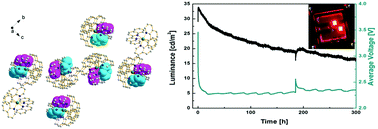Long term stable deep red light-emitting electrochemical cells based on an emissive, rigid cationic Ir(iii) complex†
Abstract
The new cationic iridium complex [Ir(bzq)2(biq)][PF6] (bzq = benzo[h]quinolinato and biq = 2,2′-biquinoline) has been synthesized for application as an emitter in light emitting electrochemical cells (LECs). The molecular structure and crystal packing of this complex were established by single X-ray diffraction (SXRD). The electrochemical and photophysical properties of the complex were examined to determine the frontier orbital energies as well as the optical transitions that led to photoemission. The complex was found to emit at 644 nm and 662 nm for powder and thin films, respectively. A high powder photoluminescence quantum yield of 25% was determined, which is attributed to a reduction in vibrational modes of the complex due to the use of the rigid cyclometalated (C^N) bzq ligand. A LEC with [Ir(bzq)2(biq)][PF6] as the emitter was fabricated which showed a deep red emission (662 nm) with a luminance of 33.65 cd m−2, yielding a current efficiency of 0.33 cd A−1 and a power efficiency of 0.2 lm W−1. Most importantly, the LEC based on [Ir(bzq)2(biq)][PF6] demonstrated a lifetime of 280 hours which is among the longest device lifetimes reported for any deep red light emitting LEC.



 Please wait while we load your content...
Please wait while we load your content...